COVID-19. We’ve been watching it from afar, as the tidal wave slowly moved closer.
And suddenly, it was here. In the U.S., businesses and schools shut down, and many professionals were jolted into improvising a home office for an indefinite work-from-home period.
The impact of COVID-19 is still uneven in communities across the country and around the world. But people everywhere are gripped with uncertainty and flooded with information as we all try to navigate the most widespread global pandemic in the age of the internet.
As a marketing agency, how should we respond? What is the appropriate role of marketing in the midst of a crisis? Is there one?
At PR 20/20, we believe there is. One of our core tenets is the belief that marketing can make brands “more human.”
How can we answer that call when a sense of humanity is needed, now more than ever?
The answers aren’t easy, or obvious.
So we started talking. We talked about what we were seeing, and how it made us feel as consumers; about opportunities for our clients to add value, and where they might take a step back; about what the future could hold, how we could prepare ourselves and our clients, and how to move forward in the midst of so much uncertainty.
Several core themes emerged:
A deep understanding of your audience is mission-critical.
There are no best practices in a crisis. As you’ll see below, the answer to “What should we do?” is often “It depends.” It depends on your company. On your brand (the relationship your audience has come to know and trust with your company). On your audience — who they are, and what they need right now.
Jeff Coyle, co-founder of MarketMuse, sums it up like this: 
Source: LinkedIn
Values matter.
Honesty, transparency, and integrity are even more essential right now. Brands are showing up in unprecedented ways to support their employees, customers and communities.
Marriott's CEO Arne Sorenson has been praised for a video to his employees, made public on Twitter, that was authentic, transparent and compassionate. In it, he spoke candidly about the challenges the business is facing, and outlined the steps he’s taking (including personally forgoing pay in 2020 and the executive team taking a 50% pay cut) to get the organization back on track.

Source: Twitter
Want your brand to be “more human?” You must show up.
Brands can only be as genuine as the people behind them. This is no time to leave your humanity at the door.
Those companies you’re marketing to are all run by people. Perhaps it took kids crashing conference calls for us to remember that the people we’re selling to have lives outside the office, families they’re juggling, elderly parents they’re worried about.
Speak to that person, and your marketing will be 10x better, always.
Here's What We're Rethinking During COVID-19
With these principles as our north star, here are some of the areas in which our team is re-evaluating marketing strategy in the coming days and weeks — along with some examples we admire.
Content
Reevaluate any content scheduled or planned for the next few weeks: Is it appropriate given the current climate? Anything that should be removed or edited?
Consider shifting toward more feel-good stories for the time being. As of this writing, many brands have interrupted their "regularly scheduled" content — and quite a few are reaching out to their audiences to ask what they want or need right now.
“Loving the brands that are showing they're very aware of what's happening but also staying in their lane and being appropriate. Glossier, for example. What is a makeup brand supposed to do amid all this? They posted this cute animal vid yesterday (in line with their brand on Insta), and asked people to comment with the content they want to see.
It’s so cool to see brands having personal conversations and really listening to their audience, especially at a time when empathy and a sense of community is really needed.” - Ashley Sams
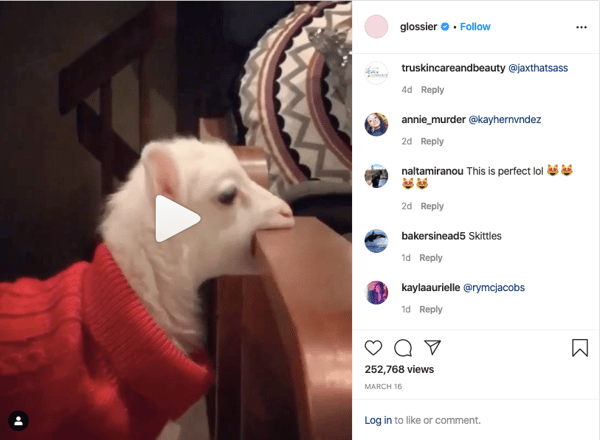
Source: Instagram
“I've been appreciating some of the content people are coming out with relevant to their brand, but that's also helpful given the situation. For example, after the Great Lakes Science Center closed, they announced that they'll do kids experiments/how-tos online everyday at a specific time to help with parents who might find themselves homeschooling. I found that a smart, helpful pivot. Same with Disney+ releasing Frozen 2 early.” - Tracy Lewis
Is there anything your brand can be doing to help alleviate some of the discomfort its audience is experiencing right now, or fill a pain point that might not have been there last week?
When deciding what the right balance is, it’s hard to know if you’re getting it right — and the truth is, you might not 100% of the time. That’s why it’s perhaps more important than ever for brands to lead with transparency.
We particularly loved this example from our own Cleveland Indians:
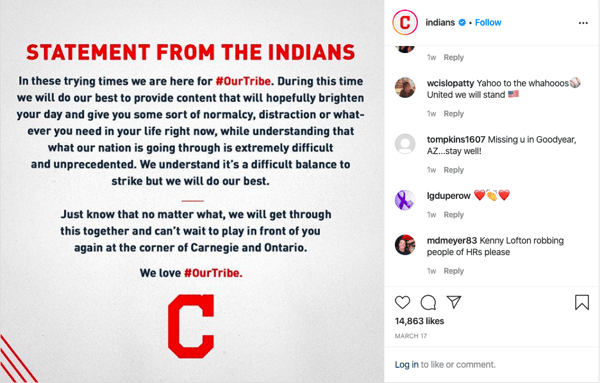
Source: Instagram
Paid
As with any paid content, you’re bound to be reaching people outside your normal audience (that’s the point). So if you’re paying to put content in front of people, your approach warrants a gut-check:
- Are there any campaigns or ads that should be paused or rethought?
- With everything else people are seeing in their feeds, how will your promoted content fit in? Does it seem inappropriate or awkward — or, is it a welcome break / useful resource?
- Is your audience even paying attention? We’re all a bit more distracted right now. Take this into consideration when allocating your near-term ad spend.
Campaign Launches
Reassess any planned campaign launches or promotion. Again, the same questions apply:
Anything that should be postponed based on sensitivity to your audience, audience distraction, market disruption or budget shifts?
If you continue with promotion, does it need to be rethought? For example: A number of brands are promoting resources, products and services with a softer, more empathetic tone ("We're here for you;” “Here's a resource if you need it"), as opposed to "Sign up today!" which could feel inappropriate, tone-deaf or opportunistic.
Depending on your industry and audience, the best course of action might be to continue with business as usual — but do so mindfully.
What not to do? Shoehorn a few vague, coronavirus-related sentences into the intro of your promotional email:
“Content marketing is a great way to tell your story, and in times of uncertainty, content marketing is more important than ever.
Join us for this 30-minute webinar where we'll share five content marketing tips…!”
It won't convince people that your preplanned webinar will help them in this time of crisis. Your audience will see through it, and you'll risk damaging your brand.
Instead, make sure campaigns and messaging are intentional and thoughtful — not an afterthought.
Internal and External Communications
Consider any proactive communications that need to be sent to internal and external audiences regarding:
- What added precautions your business is taking to protect the health of employees or customers entering its doors.
- If you’re temporarily making changes to your operations. For example, limiting in-person meetings, how goods or services are handled or delivered, office closures or altered hours of operations. (Make sure to update Google Maps or other business listings based on your current business status and operating hours.)
- Any changes in how customers can get in touch with your team, if staff will be working from home.
Send out follow-up communications as the situation changes, or better yet, create a date-stamped central landing page with the most current information that your audience can reference.
And don’t forget about one-to-one communication. Use the opportunity when contacting customers, leads, partners or suppliers to check in with them. See how they’re holding up, and if there are any additional ways you can support them right now. In addition to being a Good Human, it’ll likely leave a far more lasting impact than any marketing campaign.
Social Responsibility
Is your brand taking a proactive stance on social distancing and "flattening the curve?" Should you raise funds or donations for those being hurt by the crisis? This one very much depends on the context of your business, brand and audience.
Many brands have been stepping up to help in a variety of ways: Providing food or aid to the elderly and other vulnerable populations, to workers and families unable to earn income amid closures, and to the healthcare workers on the front lines.
If you can, find a way to give back — and rally your community to do the same.
With the food and beverage industry hit hard by closures, and demand for delivery services skyrocketing, our team pointed out this great example from GrubHub:
“There's been lots of talk about how to support local restaurants and I've seen calls to avoid delivery apps since they take a cut from the already gouged local businesses. Not only is GrubHub deferring its commission, the message actually encourages takeout instead of delivery, if the situation calls for it.
“Overall, I love the tone of this message and that it outlines multiple action steps. It shows prioritizing the betterment of community over company.” - Sandie Young
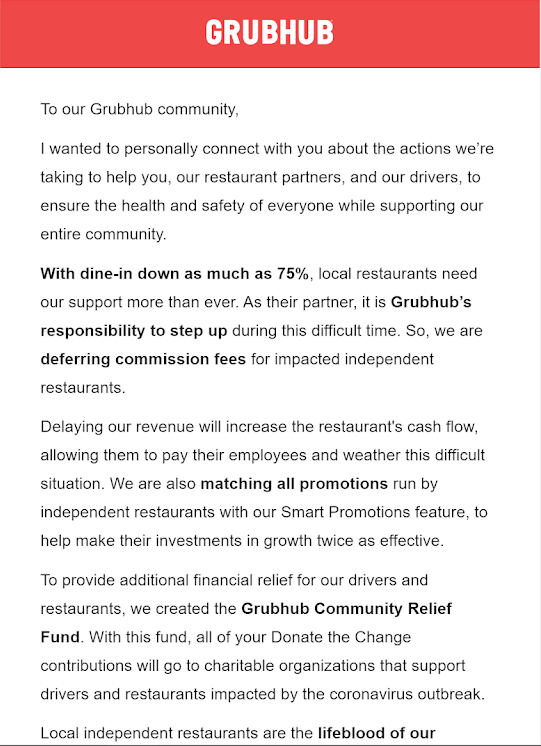
Still unsure if you should put something out there? Content marketing coach Deborah Ager started a LinkedIn thread on this very topic; see here for other pros’ thoughts.
Product
From new virtual services to online class offerings to free shipping and delivery, many businesses are making short-term changes to their business model that allow them to better serve their customer base right now.
Gather the brightest minds across departments and ask: How can we help our business succeed in perhaps new, creative ways?
HubSpot’s approach earned our praise. Founded with a mission to "Help Millions of Organizations Grow Better," the company announced temporary measures to support customers as they weather these uncertain times.
These include reduced prices to lessen the financial hardship, but also increasing email and call limits to help businesses communicate with their audiences, and more access to free tools that help businesses operate online.
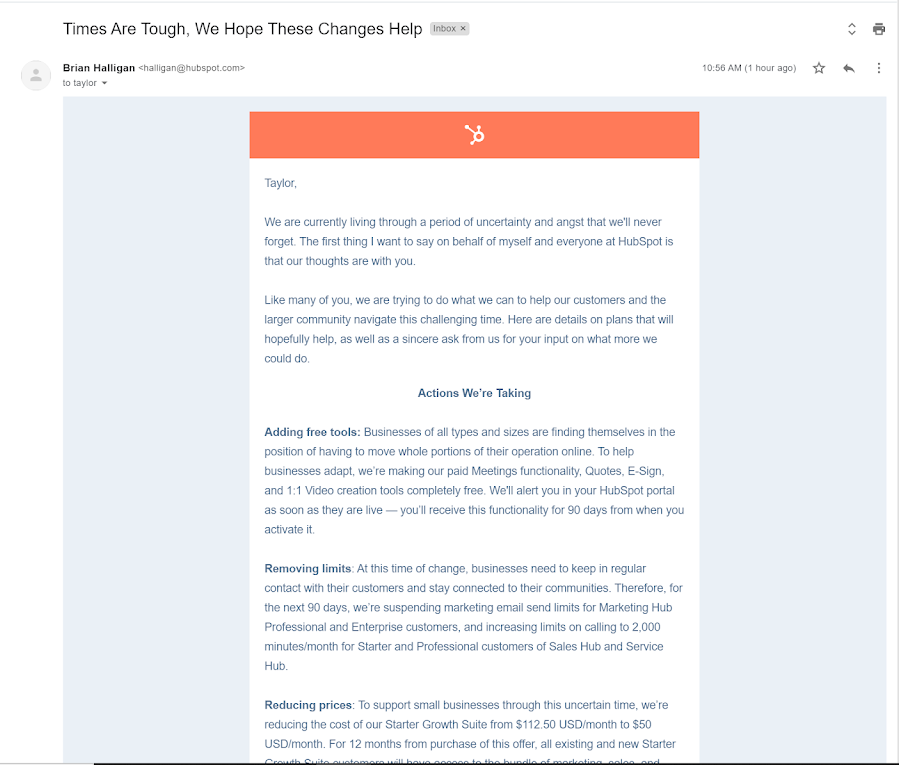
Goals & Budgets
Many businesses are facing operational disruption, if not a shutdown. As these days stretch into weeks, the financial impacts of this pandemic are affecting the budgets, goals and plans many companies had for 2020.
Each company’s situation will differ, but marketers should become laser-focused on the most essential, revenue-driving activities. Here’s where to start:
Baseline your data.
Seeing a dip in website traffic or leads? Annotate major dates in your analytics software, so you can flag external factors that may have been distracting consumers from business-as-usual:
- COVID-19 was declared a global pandemic by the World Health Organization on March 11; a national emergency was declared in the U.S. on March 13.
- When did most of your company start working from home? If employees’ home IP addresses aren’t filtered out, that could be falsely inflating traffic, so annotate accordingly.
Pivot your strategy.
The goals, KPIs and company initiatives that drove your 2020 marketing strategy are likely changing or being impacted. It’s time for nimble, agile marketing that takes its cue from the larger business and social environment.
Consider the products, services and industries you market to: Are there certain niches that make more sense to lean into than others? For example, a workwear company won’t be moving full steam ahead with their strategy to target restaurant employees in Q2. More likely, they’ll pivot to meet increased demand for healthcare uniforms.
Take a hard look at your strategy for the coming months and reevaluate as needed.
Develop a geo-targeted approach.
In the U.S., most non-essential business shutdowns and “shelter in place” orders are being dictated at the city and state level, which means your ability to deliver goods and services may be fragmented.
Develop contingency plans for how you might comply with a work-from-home order, public gathering limitations, or social distancing requirements — and what happens if non-essential businesses are shut down. Keep a pulse on city, state and federal orders, so your marketing strategy can shift as requirements are enacted, and later lifted.
Control what you can.
If traffic and leads decline over the next few weeks and months, how is your marketing poised to take really great care of the leads you do get?
In other words, what can you control?
This is the time to focus on lead nurturing. Become sharply aligned with sales. And get serious about marketing’s ROI for the big-picture business.
Look Beyond
So, what can you do? Leverage technology. Employ context. Thoughtfully segment your audiences to send the right messages to the right people. Dig into the data. See what your audience is telling you. Think outside the box.
As managing director Jessica Miller put it:
“With intelligent resources focused on a personalized customer journey and operations, brands [are] able to dedicate greater resources to creativity, listening, relationship building, culture, and community.”
As marketers, we’re called to have empathy; to profile potential customers, to connect with our audience’s pain points, to figure out what motivates them.
Today, that empathy is needed on a scale we’ve never seen before. How will you answer the call?
Edit: Real-Time Marketing Examples We Love
Since publishing this post, we've seen something truly inspiring: Even more wonderful examples of marketers and brands showing empathy, humanity and integrity in a time of crisis.
We're going to be updating this section periodically with the best examples we see "in the wild" and with what our community shares on LinkedIn, Twitter and Facebook.
Nasdaq

Source: LinkedIn
Adena Friedman, the President and CEO of Nasdaq, has been exercising outstanding internal and external leadership from the early stages of this uncertain time. As the face of the brand, her message about leaning on technology to strengthen personal connections resonated strongly.
Gap
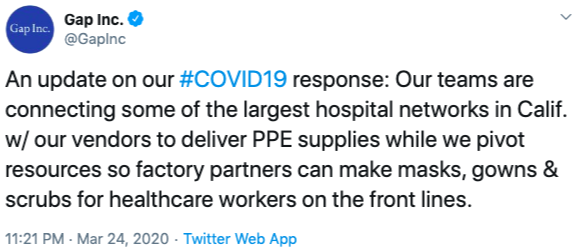
Source: Twitter
Gap Inc., whose portfolio includes a number of well-known clothing brands, announced it would be altering its production processes to develop personal protective equipment (PPE) for frontline healthcare workers. According to USA Today, Gap isn't the only brand taking on a heavy lift for social responsibility: Tesla, Ford, GM and others are reshaping their business models to help.
%20Logo_BlueOrange_Trademark.png?width=800&height=269&name=Ready%20North%20(RN)%20Logo_BlueOrange_Trademark.png)




.jpg?width=300&name=Services%20Hub%203%20(3).jpg)


COMMENTS